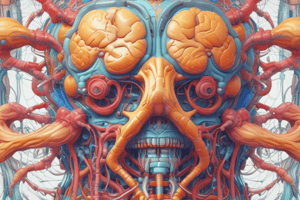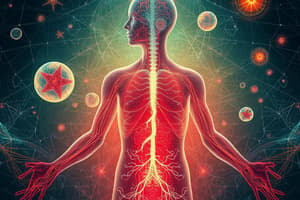Podcast
Questions and Answers
What is homeostasis?
What is homeostasis?
The ability of an organism to maintain a stable internal environment despite changes in external conditions.
Which type of feedback mechanism reduces output or activity?
Which type of feedback mechanism reduces output or activity?
- Positive Feedback
- Negative Feedback (correct)
- Both A and B
- None of the above
What role do kidneys play in osmoregulation?
What role do kidneys play in osmoregulation?
Filter blood, remove waste, and regulate water levels.
What is the purpose of aquaporins?
What is the purpose of aquaporins?
What is the primary function of insulin?
What is the primary function of insulin?
Which of the following refers to organisms that generate heat through metabolic processes?
Which of the following refers to organisms that generate heat through metabolic processes?
What processes are used by organisms to regulate temperature?
What processes are used by organisms to regulate temperature?
What does glucagon do?
What does glucagon do?
Hormonal responses typically involve positive feedback loops for regulation.
Hormonal responses typically involve positive feedback loops for regulation.
Flashcards are hidden until you start studying
Study Notes
Homeostasis
- Definition: The ability of an organism to maintain a stable internal environment despite changes in external conditions.
Feedback Mechanisms
- Types:
- Negative Feedback: Reduces the output or activity when a set point is exceeded (e.g., temperature regulation).
- Positive Feedback: Amplifies responses and increases output (e.g., childbirth).
- Process:
- Stimulus detected by a sensor.
- Control center evaluates the input.
- Effector executes the response.
Osmoregulation
- Definition: The process by which organisms regulate the water and electrolyte balance.
- Mechanisms:
- Kidneys: Filter blood, remove waste, and regulate water levels.
- Aquaporins: Channels that facilitate water transport across cell membranes.
- Importance: Maintains cell function, blood pressure, and overall fluid balance.
Hormonal Control
- Role of Hormones: Chemical messengers that regulate various physiological processes.
- Key Hormones:
- Insulin: Lowers blood glucose levels.
- Glucagon: Raises blood glucose levels.
- ADH (Antidiuretic hormone): Regulates water balance in response to hydration levels.
- Feedback Mechanisms: Hormonal responses typically involve negative feedback loops for regulation.
Thermoregulation
- Definition: The process by which organisms regulate their internal body temperature.
- Mechanisms:
- Endotherms: Generate heat through metabolic processes (e.g., mammals).
- Ectotherms: Rely on external sources for heat (e.g., reptiles).
- Processes:
- Vasodilation and Vasoconstriction: Adjust blood flow to the skin to either release or retain heat.
- Sweating and Shivering: Temperature regulation through perspiration and muscle activity.
Blood Sugar Regulation
- Process: Maintains glucose levels within a narrow range.
- Key Players:
- Pancreas: Releases insulin and glucagon.
- Action:
- Insulin: Promotes uptake of glucose by cells and conversion to glycogen.
- Glucagon: Stimulates liver to release glucose into the bloodstream.
- Homeostatic Balance: Essential for energy production and metabolic processes.
Homeostasis
- Maintaining a stable internal environment despite external changes.
- Crucial for survival and proper functioning.
Feedback Mechanisms
- Negative Feedback:
- Reduces activity or output when a set point is exceeded.
- Example: Temperature regulation - if body temperature rises, the body will sweat to cool down.
- Positive Feedback:
- Amplifies responses and increases output.
- Example: Childbirth - uterine contractions become stronger with more oxytocin release.
Osmoregulation
- Regulating water and electrolyte balance.
- Kidneys: Filter blood, remove waste, and regulate water levels.
- Aquaporins: Protein channels that facilitate water transport across cell membranes.
- Importance: Maintains cell function, blood pressure, and overall fluid balance.
Hormonal Control
- Hormones: Chemical messengers that regulate various physiological processes.
- Key Hormones:
- Insulin: Lowers blood glucose levels by promoting glucose uptake by cells and conversion to glycogen.
- Glucagon: Raises blood glucose levels by stimulating the liver to release glucose into the bloodstream.
- ADH (Antidiuretic hormone): Regulates water balance in response to hydration levels.
- Feedback Mechanisms: Hormonal responses typically involve negative feedback loops for regulation.
Thermoregulation
- Regulating internal body temperature.
- Endotherms: Generate heat through metabolic processes (mammals).
- Ectotherms: Rely on external sources for heat (reptiles).
- Processes:
- Vasodilation and Vasoconstriction: Adjusting blood flow to the skin to either release or retain heat.
- Sweating and Shivering: Temperature regulation through perspiration and muscle activity.
Blood Sugar Regulation
- Maintaining glucose levels within a narrow range, essential for energy production and metabolic processes.
- Key Players:
- Pancreas: Releases insulin and glucagon.
- Action:
- Insulin: Promotes glucose uptake by cells and conversion to glycogen.
- Glucagon: Stimulates liver to release glucose into the bloodstream.
Studying That Suits You
Use AI to generate personalized quizzes and flashcards to suit your learning preferences.




